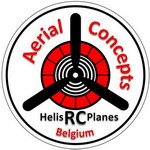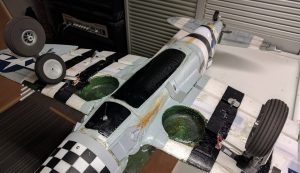Concepts, Mechanical, Scale, Plane Aerial Concepts Belgium, Patric Dietvorst, AS3X,Eflite, P-47D, Spektrum, Thunderbolt
What makes the best Warbird for grass landing? Something with bigger and particularly sturdy wheels/landing gear. The Eflite P-47D is a tail dragger and with the factory retracts and stock wheels, nose overs are occurring on take off and landings, especially when the grass is not short. A good thing is, the landing gear is wide and there are possibilities to modify the landing gear to improve stability and take flying precautions to successfully take off and land like a scale plane, also on a grass field.
I have exchanged the 2,5″ (5 cm) wheels with Dubro 3″ (7,5 cm) lightweight wheels. It’s possible to retract these wheels. They fit the openings in the wings. Use a copper bus 4-3 mm to adjust the inner diameter of the wheels. Grind away some plastic at one side of the wheel to fit the wide of the wheel on the landing gear.
I change the inclination of the landing gear to use longer bolts and spacers. The wheels are now 2 cm more to the nose of the plane. This makes a real difference.
Take off with Flaps 1/4 out. Give full elevator up before gently apply throttle to get the plane moving. Apply full throttle only when the plane is already rolling through the grass.Take off with a gentle slope. Retract the landing gear when the plane is airborne. Flaps up when leveling the plane.
Landing with maximum 1/2 flaps deployed, and with a relative fast final approach. (approx. 45-50 km/h). Start losing speed when you are 1m above and at the edge of the grass landing field. Flare when the plane is 50 cm above the field, but keep 10% -15% throttle so air keeps flowing over the wings and the plane will not tip over. Retract the flaps when you have landed. If you like to taxi, don’t stop the plane first on the grass field. Always taxi with full elevator up and flaps retracted.
Photos

